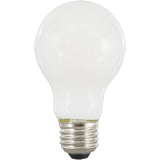What Happened to the 100,000 Hour LED Bulb?
Posted by Nick on for ProLampSales
What happened to the 100,000 hour LED bulb? Just a few years ago, numerous manufacturers advertised their LED lights lasting up to 100,000 hours. But now, many are rated at 25,000 to 50,000 hours. A fair number of large bulb manufacturers have even come out with LED lines that are rated for 11,000 hours.
So what gives? Is it a conspiracy by the lighting companies to have their lights fail sooner so you have to replace even LED bulbs a lot sooner than you could? Is planned obsolescence sending you back to the hardware store four times sooner than usual?
Not Quite A Conspiracy
Well, not quite. Those claims of 100,000 hours weren't wrong, but they weren't right, either. Because of the different type of technology between LED and previous lighting technology, rated life hour ratings lost a bit of meaning for a while.
For incandescent and halogen bulbs, a rated life of 1,000 to 2,000 hours, respectively, is quite common. At that point, the filament may break and the light simply goes out. But over those thousands of hours that the light functions, light output is declining. Because the light output declines so slightly, though, it is hardly noticeable unless the lamp lasts much longer than expected (which is unlikely).
But for LED, there is no filament that will break suddenly, causing a failure. LEDs are solid state, meaning they can output light for much longer than incandesent or halogen. Yes, that means up to 75,000 or 100,000 hours.
However, the amount of light an LED emits, just like with incandescent and halogen, declines over time. With the much longer lives of LEDs, though, this can become noticeable because the lamp lasts for so long.
The industry has established a new type of rated life for LEDs, referred to as L70. This refers to the estimated time it takes for the LED to reach 70% of its original light output.
A light can decline 30% over its lifetime without a noticeable difference, but as it declines more than that, humans notice the dimness. It's that point that is counted as the end of life for LED bulbs -- not simply when the technology will fail, which may be much longer than the rated life.
So the 100,000 hour LED bulb didn't disappear -- it just got redefined.
Component Life Makes A Difference, Too
One other consideration is the component life of LED bulbs. LEDs are basically little computers, so diode itself may still function fine when the heat sink or other component fails. This is why LEDs are not recommended for use in high-heat applications with enough ventilation for heat dissipation.
However, the cheaper the components, the more likely the lamp fails earlier. This is one cause for lower-rated lives of some LEDs, but also the lower cost of some of these LEDs compared to ones rated for 25,000 or 50,000 hours.
- Posted in LED
Featured Products (View All)
0 Comments




